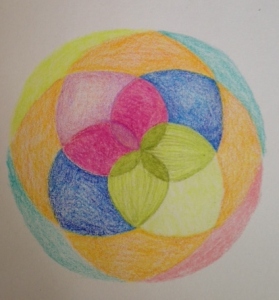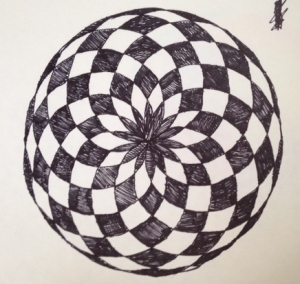Flipping the calendar to August and seeing the words “retreat and teacher workdays” on the page was a little bit of a shock, I have to say. But I’m feeling more and more ready. I’ve been at work on my arts integration plan.
I found out about the the national core standards during a Kennedy Center workshop, and so I just read through them. This was extremely helpful to me because they bring up questions and concepts I would have never thought of. For example, the idea that students should be planning their project and choosing an appropriate medium makes a lot of sense, but it’s not something I’ve been having them do. If I introduce a math/art thing, I usually just tell them what to do and how to do it, then help them with the math if they need it.
The concept behind arts integration is that the students learn an art form and the math content in ways that are “mutually reinforcing.” The art standard that most closely mirrored a math standard was “Through experimentation, practice, and persistence, demonstrate acquisition of skills and knowledge in a chosen art form,” which could reinforce and be reinforced by “Make sense of problems and persevere in solving them.” I love the wording behind both of these because they don’t expect us to be talented or to find clarity instantly, they encourage us to keep working even if things aren’t coming naturally. That’s a huge issue in both math and art, the notion that it’s only for people with a natural aptitude.
The project that I’m most excited about trying next year is a rose curve/ op art/ colored pencil task. In the past I’ve just told students “a rose curve is in the form r = a sin (theta b)” and told them what a and b do. Then I’ve taught them the other types of polar graphs similarly, with notes. This year I want them to investigate using different coefficients to see what types of graphs are created, then generalize. Then I want them to choose two and color them either in black and white, or in colored pencils, and explain why they chose the graphs they chose. I made some examples and they look pretty neat.
I just really want to make sure that when we’re doing this, they understand a) what polar graphs are, and the different categories they fall into b) what types of equations generate rose curves c) good colored-pencil techniques so that these actually look decent [my example could totally be better] d) what would create an appealing black-and-white “op-art” style piece [so why would I not have chosen the first curve to color in black and white]
Once we’ve got all that, then we can talk about fun things like converting between rectangular and polar. The company I’m tutoring with lets us write problem sets for $$$, and I just wrote a bunch of those problems. I hadn’t done that math in a while and it’s actually great.
In terms of other arts integration stuff, I still need a lot of help with my sine curves/ jazz unit, and I’m also developing a similar figures/ architectural drawing project, right now mainly by reading through all the architectural drawing books at the library. Stay tuned for whatever I end up with!


